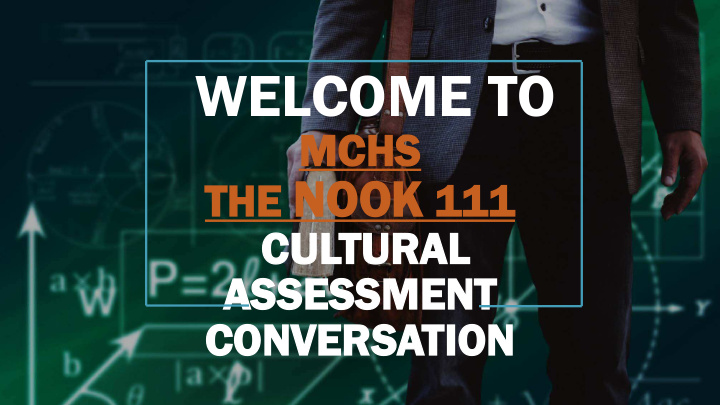



WELCOME TO MCHS MCHS THE NOOK NOOK 111 THE 111 CUL CULTURAL TURAL ASSESS ASSESSME MENT NT CONVERS CONVERSATI TION ON
Our Team 2
A Sample List of Clients 3 Corporations Snapchat AGB Investigative Services Exelon Corporation (strategic alliance) ZS & Associates (strategic alliance) Municipalities & Government Agency The United Nations The Village of Glenview The Village of Glencoe Colleges, School Districts and Universities Joliet Junior College Zion School District (strategic alliance) Waukegan School District (strategic alliance) The City of North Chicago (strategic alliance) Lake County State’s Attorney’s Office (strategic alliance) College of Lake County
33 Real eality i ity is per perceptio eption n from o our r poi oint of of view ew
Our perceptions are reinforced by what we’ve been taught….
CULTURAL ASSESSMENT - PURPOSE 6 1 2 To better understand the Create a baseline for perceptions of students monitoring the progress of and employees through the diversity journey and a diversity lens other key initiatives
Even though students may 7 be highly prepared, the anxiety they experience from worrying whether their peers and teachers believe stereotypes to be true is distressful enough to lower performance. Roach, 200
Key Terms Age School Diversity Physical Abilities Division/Departme • Those different characteristics Race nt Ethnicity Role/Function that make each one of us Gender Leadership Level unique. Sexual Orientation Level of Primary Organizational Contribution Inclusion • Creating an environment that engages all students and Education Income encourages student success Communication Language Secondary Work Style Behavior Religion Style of Leadership Cultural Awareness Marital Status Learning Style Parental Status • Becoming aware of the values, Personality Military Experience Work Habits beliefs and communication Geographic Location Performance styles of ourselves and others Country of Citizenship
Survey • Sent electronically to all students and employees Focus Groups – White Students – African American Students – Latino Students – Freshmen Students (mixed race) – White Teachers – African American Teachers – Latino Teachers – Staff (Less than 2 years) – Staff (10+ years) Key Interviews
• By encouraging an exchange of diverse Benefits 10 viewpoints in a confidential, non-confrontational setting, participants learn that there is a willingness to listen which in itself creates the space for positive interaction and builds trust in the process • Focus group participants realize that they are part of the change process • New and renewed commitment is established • Enhance and clarify other District information gathering by “going deeper” than the Cultural Survey
Why Diversity, Inclusion and Culture Matter For S or Scho hool D Distri ricts To keep pace in today's complex and competitive global arena, American high school education must retire old notions of educational exclusivity and embrace new models of inclusive excellence . For S or Students Creating environments where EVERYONE feels safe, incorporating diverse content, perspectives, and approaches into the curriculum, faculty prepares students for engagement with today’s competitive college and working world.
Making “Diversity” More Inclusive “Culture” is often viewed in the U.S. as being primarily related to race, ethnicity, and gender However, organizations, particularly school districts, must also address other kinds of diversity which lead to marginalization and exclusion.
Cross Cultural 13 • Developing an awareness of one's own culture, existence, sensations, thoughts, Competence and environment; • Accepting and respecting cultural “The P Purnell M Model f for Cultur ural differences; Comp mpetence” • Resisting judgmental attitudes such as Jou ournal of of M Multicultural C Cou ounseling a and Health "different is not as good;" and Summer er 2 2005 • Being open to cultural encounters; • Being comfortable with cultural encounters.
14 WHAT DO YOU SEE?
Cros oss C Cult ltural l 15 Com ompet petence In Inclu ludes des: Ha Havin ing g the c cap apac acity t to: : Condu onduct ct s self-ass ssess ssment Conduct an an organ ganiza zational ( (Di District) asse sessm ssment Valu alue d div iversity Man Manage age the d dynam amics o of dif ifference Acquire a and inst stitutional alize ze cultural al knowledge ge Adap apt t to t the div iversity an and cultural context xts o of in indiv ividuals an and communities y you serve
What We Need from You 17 Awareness Participate!!! Champion Execution Understand for yourself why • Take the Survey and • Provide ample time for • we are engaging in this participate in focus groups questions during and after Assessment process if selected class And Encourage your colleagues • • Provide resources for Identify your personal “why” • and students to participate questions you can’t answer • Show enthusiasm for the process
Recommend
More recommend